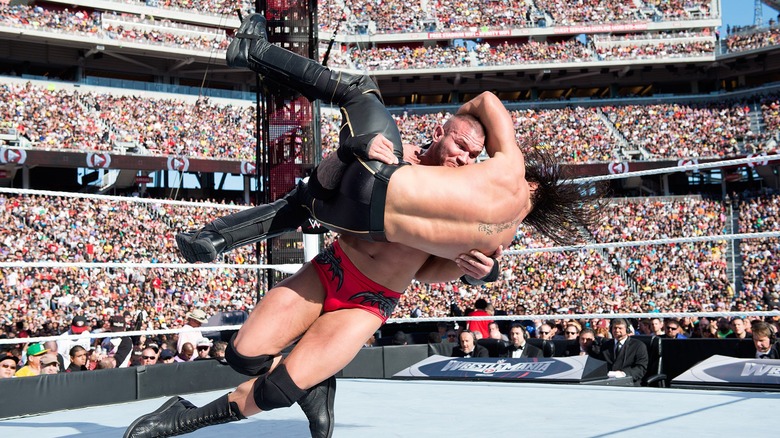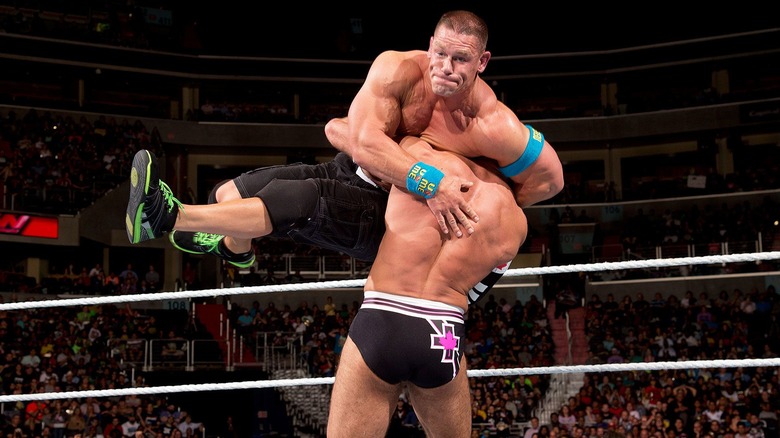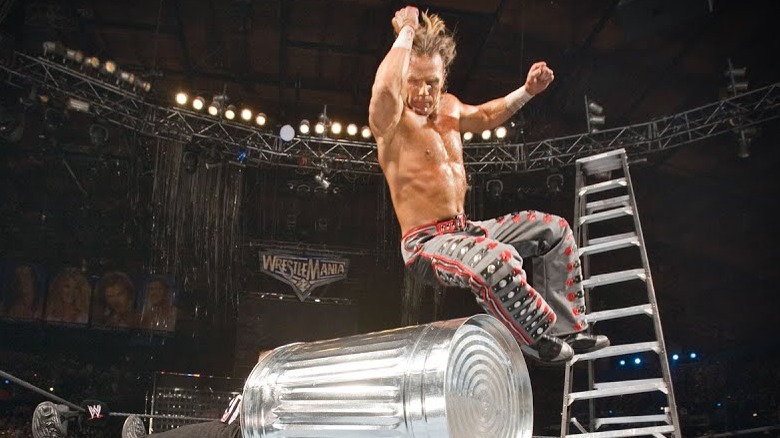The Secret Signals In Wrestling Explained
As a closed-off world bordering on a secret society, particularly in decades past, pro wrestling has a language of its own. In terms of spoken and written language, this manifests in all of the insider terms that you had to familiarize yourself with when you started following wrestling news online: "Shoot," "work," "kayfabe," "blade"/"gig," "babyface," "broadway," and so on. Naturally, this also extends non-verbal communication: How to signal that a wrestler is injured (or, conversely, not injured in the event of concern for a possible injury), how to call variations on certain spots when speaking "the language of wrestling," giving someone a heads up, and so on.
Let's take a peek behind the curtain to go over some of these coded gestures and other kinds of signals. Fair warning: Once you see some of these, un-seeing them is probably going to be a bit of an adjustment, like watching WWE after having the quick camera cuts pointed out to you. The same can easily be said for some of the ways that wrestlers and/or referees communicate nonverbally.
The dreaded X
Wrestlers are supposed to be good at making you think that they're legitimately injured in a way that's designed to play on your emotions. You want everything to look believable. By that same token, you also want easy ways of communicating that something has genuinely gone wrong.
That's where the "dreaded X" sign used by referees comes in. Popularized in WWE, it involves a referee crossing their arms above their head to make an "X," signifying a legitimate injury. It's an easy shorthand that can also be used by wrestlers — who don't have two-way radios like the referees working TV have — if need be. When discussing the "X" on his podcast, former WWE producer Arn Anderson explained it as signifying an immediate need for a doctor that called for the match to come to a halt.
Though WWE has used the "X" for storyline injuries in the past — John Cena repeatedly making the "X" after Kane pushed Zack Ryder off the entrance stage in a wheelchair comes to mind — this practice has fallen out of favor. Speaking to Wrestling Inc., former NXT referee Jake Clemons noted that he was never taught any variations of the "X" or told how to use it outside of legitimate injury situations, so that toothpaste appears to have been put back in the tube.
Squeezing the hand of the referee or opponent to show you're OK
Referees in pro wrestling have a slew of different roles they have to fill, many of which aren't obvious. Ensuring the safety of the wrestlers is their most important job, though, to the point that referees getting formal first aid training has become increasingly common. And just like they need a standardized way to quickly notify everyone who can see them that a legitimate injury has taken place, they also need a standardized way to check on the wrestlers. There is one, and it's pretty simple: As laid out in a YouTube video from Wrestlelamia, you just put your hand in the hand of the wrestler who took the bump to make sure they "give you the iggy" or squeeze it. And this isn't just for referees: The wrestler giving the move often does this to make sure that the wrestler taking the move is okay, as well.
"The hand squeeze, from what I understood was a way to protect the business from nearby fans to check on the performer," explains former WWE NXT referee Jake Clemons. "I myself use it from time to time, but now I find myself just speaking to talent more often, because I feel as if the fans know about the hand squeeze now."
Randy Orton clapping before a power slam
One of Randy Orton's signature moves has long been his snap powerslam. His execution on it is fantastic, and pretty unique, to boot, with only Dustin Rhodes having a similar take on the turning powerslam that was popularized by the likes of Buzz Sawyer and Rick Steiner in the 1980s. And Orton does it in such a particular way, with so much speed and explosion, that a somewhat common spot in his repertoire is to over-commit to the power slam, only for his opponent to stop short of walking into it, sending "The Viper" spinning and crashing into the mat.
As it turns out, there appears to be a very easy to decode signal used by Orton when calling the match that makes it clear to his opponent if they're doing an actual power slam or the missed powerslam counter spot. As is pointed out in a YouTube video by Tap Out Corner that uses multiple examples, Orton always claps his hands when he's about to actually hit the powerslam. If he doesn't? That's how you know that his opponent is going to stop short and cause Orton to crash and burn onto the ring canvas. This is one of those things that you won't be able to unsee once you notice it.
Slapping the back before a DDT
Speaking of which, on a similar note, there's the DDT. Popularized in the mid-1980s by Jake "The Snake" Roberts, it starts as a front facelock and drives the opponent straight down to the mat from that position. (Whether it ends up more like a piledriver or a face-first bump is up to how adventurous the wrestlers doing the spot are.) With Jake's ability to hit it out of nowhere — think Randy Orton and the RKO — the DDT got so over that it helped turn him babyface, both in Mid-South Wrestling and the WWF.
While Jake didn't invent the DDT, he did add a flourish that's not present in the available footage of it being used by the wrestler generally credited with inventing it, Black Gordman. Whenever Jake hit the DDT, he always slapped his opponent's back as he was executing the move. The aforementioned Tap Out Corner YouTube channel spotted a pattern in the slaps—whether by Jake or wrestlers who used the DDT later — that, like with Randy Orton's clapping, you won't be able to unsee once you see it. When the wrestler executing the DDT slaps the back of their opponent, the opponent actually takes the DDT. When there's no slap? It's countered.
The referee squeezed Vince McMahon's leg so he'd be ready for Shawn Michaels' elbow drop at WrestleMania 22
At 2006's WrestleMania 22 in Chicago, Shawn Michaels took a break from being in the intended show stealer to be the man that would lead Vince McMahon to a memorable WrestleMania match. The climax of the match, which Michaels won, of course, was Michaels coming off the top of a very tall ladder with an elbow drop, putting McMahon through a table.
"While that sounded and looked impressive, to the wrestlers it was even more so because McMahon had a garbage can around his head," wrote Dave Meltzer in the April 10, 2006 issue of his Wrestling Observer Newsletter. "That meant he actually couldn't see Michaels falling and tense himself to take the blow, which is a big deal. In boxing, the gimmick when you see a boxer stick his chin out and dare the guy to hit it, the bottom line is if you see the punch coming and ready for it, you can tense yourself."
Impressive, right? Well ... not as much as it looked at first. "Vince McMahon was working a lot of the wrestlers regarding the Michaels match," Meltzer added in the May 10 Observer. "Vince was getting over how gutsy he was taking that elbow with the garbage can over his head because unlike most who would be taking it, they know when it's coming so they can tense and prepare. He had to tense for a long period of time, not knowing when it was coming. In actuality, the ref shook Vince's leg right as Michaels was about to land, so he was given a signal." Are you really surprised, though?
In the '80s, WWF wrestlers were only supposed to hook the leg at the finish
If you've watched your fair share of WWF wrestling from the 1980s, then surely you remember one of the constants of Gorilla Monsoon's commentary: Admonishing wrestlers for not hooking a leg on pin attempts. On the surface, it made sense: Hooking and elevating the legs to get weight up over the shoulders is a legitimate strategic principle from amateur wrestling, after all. The wrestlers of the WWF at the time didn't see it that way, though. Why? Because one of the tenets of that era's WWF wrestling style was to never hook the leg on near falls, only at the finish of the match.
"You do a near fall and don't hook the leg, and he calls you an idiot for not hooking the leg and teaches the fans not to pop for your near fall when the style you are told to do is only hook the leg for the real finish," wrote Wrestling Observer Newsletter editor Dave Meltzer in a post on the WrestlingClassics.com message board that appears to have disappeared but has been archived elsewhere. "The wording was that he is trying to show how smart he is by never selling your near falls, thus hurting your match."
As Meltzer explained it, he regularly spoke to "irate wrestlers" who "hated Monsoon killing their psychology." And not just with pins, either: Monsoon would routinely put over all of the babyfaces as tough guys who would never submit, but since the house style dictated that babyfaces would never submit, he looked like a genius and it undermined the heels who tried to use submission holds.






